The global air to ground ejector racks market is projected to grow from USD 644.3 million in 2025 to approximately USD 874.3 million by 2035, recording an absolute increase of USD 230.2 million over the forecast period. This translates into a total growth of 35.7%, with the market forecast to expand at a compound annual growth rate (CAGR) of 3.1% between 2025 and 2035. The overall market size is expected to grow by nearly 1.36X during the same period, supported by the rising adoption of advanced munition systems and increasing demand for specialized ejector rack solutions across military aviation platforms.
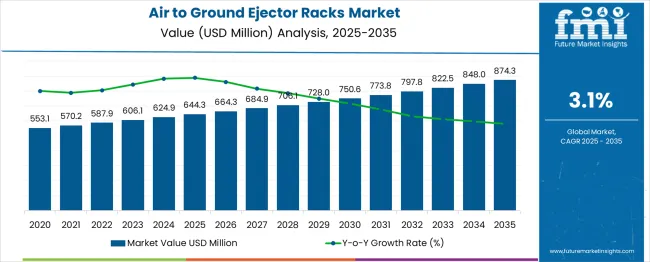
Between 2025 and 2030, the air to ground ejector racks market is projected to expand from USD 644.3 million to USD 750.6 million, resulting in a value increase of USD 106.3 million, which represents 46.2% of the total forecast growth for the decade. This phase of growth will be shaped by rising modernization programs of military aircraft fleets globally, increasing defense spending on precision strike capabilities, and growing demand for multi-mission aircraft configurations. Defense contractors are expanding their ejector rack capabilities to address the growing complexity of modern munition integration requirements.
From 2030 to 2035, the market is forecast to grow from USD 750.6 million to USD 874.3 million, adding another USD 123.9 million, which constitutes 53.8% of the overall ten-year expansion. This period is expected to be characterized by expansion of next-generation fighter aircraft programs, integration of smart munition systems, and development of standardized ejector rack interfaces across different aircraft manufacturers. The growing adoption of unmanned combat aerial vehicles (UCAVs) and multi-role fighter aircraft will drive demand for more sophisticated ejector rack systems and specialized technical solutions.
| Metric | Value |
|---|---|
| Estimated Value in (2025E) | USD 644.3 million |
| Forecast Value in (2035F) | USD 874.3 million |
| Forecast CAGR (2025 to 2035) | 3.1% |
Between 2020 and 2025, the air to ground ejector racks market experienced steady expansion, driven by increasing military modernization programs and growing adoption of precision-guided munitions. The market developed as defense manufacturers recognized the need for advanced ejector rack systems to support modern multi-role aircraft operations. Military forces and aircraft manufacturers began emphasizing standardized ejector rack solutions to maintain operational flexibility and mission effectiveness.
Market expansion is being supported by the rapid increase in military aircraft modernization programs worldwide and the corresponding need for advanced ejector rack systems to support diverse munition types. Modern military aircraft rely on versatile ejector rack configurations to ensure proper deployment of various air-to-ground munitions including bombs, missiles, and precision-guided weapons. Even minor aircraft modifications or mission requirement changes can necessitate comprehensive ejector rack upgrades to maintain optimal weapon delivery capabilities and mission success rates.
The growing complexity of modern munition systems and increasing operational requirements are driving demand for specialized ejector rack solutions from certified manufacturers with appropriate technical expertise and production capabilities. Military procurement agencies are increasingly requiring advanced ejector rack configurations to support multi-mission aircraft operations and ensure weapon system compatibility. Regulatory requirements and aircraft manufacturer specifications are establishing standardized ejector rack protocols that require specialized manufacturing capabilities and certified technical solutions.
The market is segmented by aircraft platform, munition interface, actuation type, customer region, and manufacturer location. By aircraft platform, the market is divided into fighter/strike, trainer/light attack, UAV/UCAV, special mission, and others. Based on munition interface, the market is categorized into MER/TER racks, missile/rocket launchers, single bomb racks, and smart racks/adapters. In terms of actuation type, the market is segmented into pyrotechnic, pneumatic, and hydraulic systems. By customer region, the market is classified into North America, Europe, Asia-Pacific, Middle East, and Rest of World. Manufacturer analysis covers major defense contractors across key producing nations.
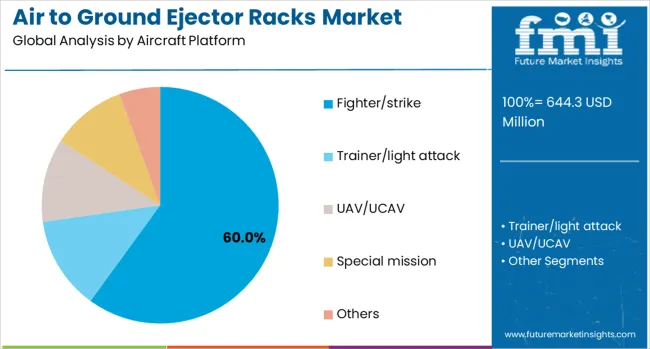
The fighter/strike aircraft platform segment is projected to account for 60% of the air-to-ground ejector racks market in 2025, highlighting its leadership within the defense aviation sector. Multi-role fighter aircraft, such as the F-35, F-16, Rafale, and Su-30, form the backbone of global air combat fleets, with missions that frequently require precision ground attack capabilities. Ejector racks are integral to these aircraft, enabling safe, reliable carriage and release of a wide range of munitions, from guided bombs to air-to-ground missiles.
The complexity of modern mission profiles demands advanced rack configurations with compatibility across diverse payloads and weapon system upgrades. This segment is strongly supported by ongoing modernization programs and next-generation fighter aircraft procurements, which include integration of sophisticated ejector rack solutions. As nations prioritize versatile, high-performance strike capabilities, fighter/strike platforms will continue to dominate ejector rack demand globally.
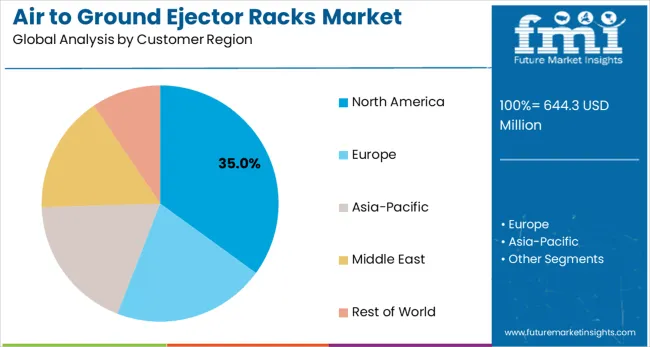
North America is projected to represent 35% of the air-to-ground ejector racks market in 2025, underscoring its role as the largest regional customer. The United States and Canada maintain extensive fleets of fighter aircraft, supported by robust defense budgets that prioritize modernization and sustainment of air combat capabilities. Programs such as the F-35 Joint Strike Fighter, F-15EX, and upgrades to legacy platforms continue to drive demand for advanced ejector rack systems.
North America also benefits from the presence of major defense contractors and integrators who specialize in weapon release technologies, ensuring continuous innovation and system upgrades. Frequent training, high operational tempo, and the need for compliance with evolving mission requirements further reinforce replacement and retrofit cycles. With sustained investment in next-generation platforms and extensive operational requirements, North America remains the central hub for ejector rack procurement and deployment.
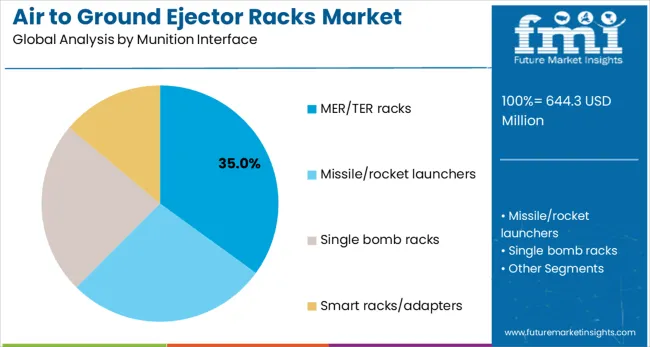
The MER (Multiple Ejector Rack) and TER (Triple Ejector Rack) systems segment is forecasted to account for 35% of the air-to-ground ejector racks market in 2025, reflecting their enduring importance in multi-mission operations. These racks enable carriage of multiple munitions on a single aircraft hardpoint, greatly enhancing payload flexibility and mission endurance. Their versatility allows integration with a variety of weapon types, including general-purpose bombs, cluster munitions, and guided ordnance, ensuring broad compatibility with both modern and legacy aircraft.
MER/TER racks are particularly valuable in strike operations requiring rapid deployment of multiple weapons against diverse target sets. The segment benefits from growing demand for operational flexibility, as armed forces prioritize platforms capable of executing multiple mission profiles without reconfiguration. Their proven reliability and cost-effectiveness ensure MER/TER systems remain critical components of global military aviation arsenals.
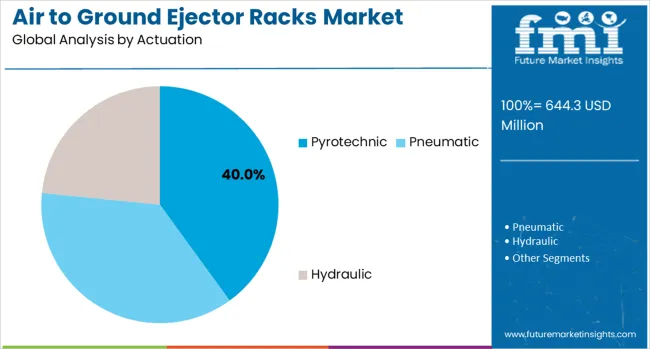
The pyrotechnic actuation segment is projected to account for 40% of the air-to-ground ejector racks market in 2025, reflecting its proven dominance in weapon release applications. Pyrotechnic systems use controlled explosive charges to achieve instantaneous separation of munitions from the aircraft, ensuring precise timing and reliability across diverse operational environments. Their performance is especially critical in high-speed and low-altitude strike missions, where safe and accurate weapon release directly impacts mission success.
Pyrotechnic ejector racks are widely adopted across fighter, bomber, and multi-role aircraft, benefiting from decades of operational validation and well-established supply chains. Despite the emergence of alternative actuation methods such as pneumatic or electromechanical systems, pyrotechnic racks remain the preferred choice for many air forces due to their simplicity, robustness, and cost-effectiveness. Continued reliance on mission-critical reliability secures their position as the leading actuation type in the market.
The air to ground ejector racks market is advancing steadily due to increasing military modernization programs and growing recognition of advanced weapon system integration importance. However, the market faces challenges including high development costs, need for continuous adaptation to new munition systems, and varying integration requirements across different aircraft manufacturers. Standardization efforts and certification programs continue to influence product development and market adoption patterns.
The growing deployment of precision-guided munitions is driving demand for smart ejector rack systems with advanced interface capabilities and real-time communication features. Modern ejector racks incorporate sophisticated electronic interfaces that support weapon system programming and mission-specific configurations. These systems enable precise weapon delivery and enhanced operational effectiveness while providing comprehensive mission data recording and analysis capabilities.
Defense contractors are developing modular ejector rack designs that support multiple aircraft platforms and diverse munition configurations. Standardized mounting interfaces and universal compatibility features reduce logistical complexity and maintenance requirements across military fleets. Advanced modular designs also support rapid mission reconfiguration and operational flexibility for multi-role aircraft operations.
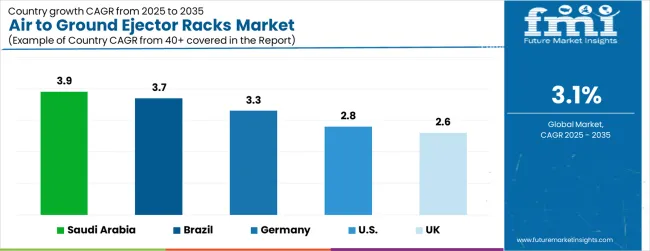
| Country | CAGR (2025 to 2035) |
|---|---|
| Saudi Arabia | 3.9% |
| Brazil | 3.7% |
| Germany | 3.3% |
| United States | 2.8% |
| United Kingdom | 2.6% |
The air to ground ejector racks market is growing steadily, with Saudi Arabia leading at a 3.9% CAGR through 2035, driven by substantial defense modernization programs, fighter aircraft acquisitions, and expanding military aviation capabilities. Brazil follows at 3.7%, supported by indigenous aircraft development programs and increasing defense technology investments. Germany grows at 3.3%, emphasizing advanced manufacturing capabilities and export-oriented defense production. The United States records 2.8%, focusing on next-generation fighter programs and military modernization initiatives. The United Kingdom shows 2.6% growth, concentrating on advanced aerospace technologies and international defense partnerships. Overall, Saudi Arabia and Brazil emerge as leading drivers of regional ejector racks market expansion.
The report covers an in-depth analysis of 40+ countries; five top-performing countries are highlighted below.
Revenue from air to ground ejector racks in Saudi Arabia is projected to exhibit strong growth with a CAGR of 3.9% through 2035, driven by comprehensive military modernization programs and substantial investments in advanced fighter aircraft capabilities. The kingdom's expanding military aviation sector and growing indigenous defense manufacturing capabilities are creating significant demand for sophisticated ejector rack systems. Major defense partnerships and technology transfer agreements are establishing comprehensive ejector rack production and maintenance capabilities.
Revenue from air to ground ejector racks in Brazil is expanding at a CAGR of 3.7%, supported by indigenous fighter aircraft development programs and growing emphasis on domestic defense manufacturing capabilities. The country's established aerospace industry and increasing military modernization efforts are driving demand for advanced ejector rack solutions. Local defense manufacturers and international partnerships are gradually establishing comprehensive ejector rack production and integration capabilities.
Revenue from air to ground ejector racks in Germany is growing at a CAGR of 3.3%, driven by the country's emphasis on advanced aerospace manufacturing and precision engineering capabilities. German defense contractors are implementing comprehensive ejector rack production that meets stringent quality standards and international military requirements. The market is characterized by focus on technical innovation, advanced materials integration, and compliance with comprehensive defense industry regulations.
Demand for air to ground ejector racks in the USA is expanding at a CAGR of 2.8%, driven by next-generation fighter aircraft programs and comprehensive military modernization initiatives. Large defense contractors and specialized manufacturers are establishing advanced ejector rack capabilities to serve diverse military requirements. The market benefits from substantial defense spending and long-term aircraft modernization programs that require sophisticated weapon integration solutions.
Demand for air to ground ejector racks in the UK is expanding at a CAGR of 2.6%, supported by advanced aerospace technology development and international defense partnership programs. British defense contractors are implementing sophisticated ejector rack manufacturing that supports both domestic military requirements and international export opportunities. The market is characterized by emphasis on innovation, advanced materials, and comprehensive system integration capabilities.
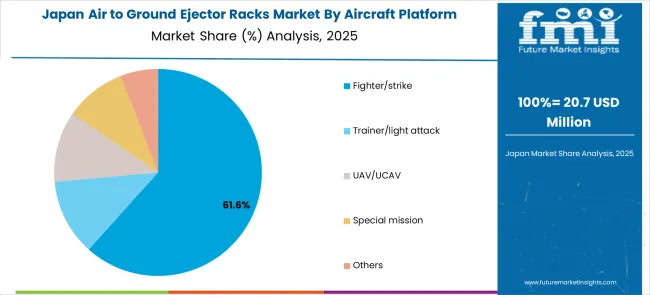
In Japan, the air to ground ejector racks market demonstrates strong demand across fighter/strike aircraft platforms, which account for 61.6% of total market demand in 2025. The high concentration reflects Japan's emphasis on advanced fighter aircraft capabilities and comprehensive air defense modernization programs. Trainer/light attack aircraft, UAV/UCAV platforms, and special mission aircraft each contribute 10% respectively, representing diversified military aviation requirements and growing unmanned systems adoption.
In South Korea, the market shows balanced distribution across actuation technologies, with pneumatic systems leading at 45% market share in 2025. Pneumatic actuation provides reliable weapon release performance and widespread compatibility across military aircraft platforms. Pyrotechnic systems account for 35%, offering proven reliability for critical military applications. Hydraulic systems contribute 20%, serving specialized aircraft configurations and advanced weapon integration requirements.
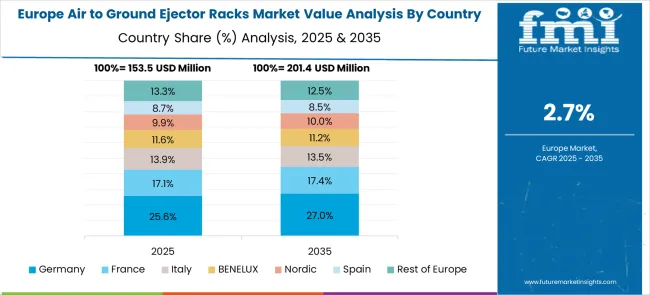
The air to ground ejector racks market in Europe demonstrates advanced development across major economies with the UK leading through its aerospace engineering expertise and defense industry capabilities, supported by companies like BAE Systems and MBDA pioneering innovative ejector rack technologies for diverse military aircraft applications. Sweden shows significant strength through Saab AB, leveraging expertise in fighter aircraft systems and advanced weapons integration solutions. France contributes through MBDA's European operations and established defense aerospace industry, while Germany exhibits expanding defense capabilities and NATO interoperability requirements.
Italy and Spain show growing adoption in military modernization programs, driven by alliance commitments and defense industry development initiatives. The market benefits from NATO standardization requirements, collaborative defense programs, and the region's leadership in aerospace engineering, positioning Europe as a key innovation center for next-generation ejector rack solutions across fighter aircraft, multi-role platforms, and unmanned systems requiring advanced weapons integration, precision release mechanisms, and interoperable defense systems supporting alliance operations and national security objectives in evolving threat environments requiring sophisticated air-to-ground engagement capabilities.

The air to ground ejector racks market is defined by competition among established defense contractors, aerospace manufacturers, and specialized weapon system integrators. Companies are investing in advanced manufacturing technologies, modular design capabilities, standardized interfaces, and comprehensive testing facilities to deliver reliable, effective, and mission-capable ejector rack solutions. Strategic partnerships, technological innovation, and international market expansion are central to strengthening product portfolios and market presence.
BAE Systems, UK-based, offers comprehensive ejector rack solutions with emphasis on advanced materials, modular designs, and multi-platform compatibility. Boeing Defense, USA, provides integrated ejector rack systems supporting major military aircraft programs with standardized interfaces and proven reliability. Elbit Systems, Israel, delivers technologically advanced ejector rack solutions with smart integration capabilities and comprehensive testing validation. HAL (Hindustan Aeronautics), India, emphasizes domestic manufacturing and technology transfer programs for indigenous aircraft applications.
Lockheed Martin, USA, offers ejector rack systems integrated with major fighter aircraft programs and advanced weapon integration capabilities. MBDA, Europe, provides specialized ejector rack solutions supporting diverse missile and munition systems across international markets. Mitsubishi Heavy Industries, Japan, delivers precision-engineered ejector racks with advanced manufacturing capabilities. Rafael Advanced Defense Systems, Israel, Raytheon (RTX), USA, and Saab AB, Sweden, offer specialized ejector rack expertise, innovative technologies, and comprehensive system reliability across global defense markets.
| Items | Values |
|---|---|
| Quantitative Units (2025) | USD 644.3 million |
| Aircraft Platform | Fighter/Strike, Trainer/Light Attack, UAV/UCAV, Special Mission, Others |
| Munition Interface | MER/TER Racks, Missile/Rocket Launchers, Single Bomb Racks, Smart Racks/Adapters |
| Actuation Type | Pyrotechnic, Pneumatic, Hydraulic |
| Customer Region | North America, Europe, Asia-Pacific, Middle East, Rest of World |
| Regions Covered | North America, Europe, Asia-Pacific, Middle East, Rest of World |
| Countries Covered | United States, Canada, United Kingdom, Germany, France, China, Japan, South Korea, Brazil, Australia and 40+ countries |
| Key Companies Profiled | BAE Systems, Boeing Defense, Elbit Systems, HAL (Hindustan Aeronautics), Lockheed Martin, MBDA, Mitsubishi Heavy Industries, Rafael Advanced Defense Systems, Raytheon (RTX), and Saab AB |
| Additional Attributes | Dollar sales by rack configuration and payload capacity, regional demand trends, competitive landscape, buyer preferences for modular versus fixed systems, integration with next-gen aircraft platforms, innovations in lightweight materials, rapid release mechanisms, and stealth-compatible designs |
The global air to ground ejector racks market is estimated to be valued at USD 644.3 million in 2025.
The market size for the air to ground ejector racks market is projected to reach USD 874.3 million by 2035.
The air to ground ejector racks market is expected to grow at a 3.1% CAGR between 2025 and 2035.
The key product types in air to ground ejector racks market are fighter/strike, trainer/light attack, uav/ucav, special mission and others.
In terms of munition interface, mer/ter racks segment to command 35.0% share in the air to ground ejector racks market in 2025.






Full Research Suite comprises of:
Market outlook & trends analysis
Interviews & case studies
Strategic recommendations
Vendor profiles & capabilities analysis
5-year forecasts
8 regions and 60+ country-level data splits
Market segment data splits
12 months of continuous data updates
DELIVERED AS:
PDF EXCEL ONLINE
Airless Paint Spray System Market Size and Share Forecast Outlook 2025 to 2035
Air Caster Skids System Market Size and Share Forecast Outlook 2025 to 2035
Airborne Molecular Contamination Control Services Market Forecast and Outlook 2025 to 2035
Airflow Balancer Market Size and Share Forecast Outlook 2025 to 2035
Aircraft Cabin Environment Sensor Market Forecast and Outlook 2025 to 2035
Aircraft Flight Control System Market Size and Share Forecast Outlook 2025 to 2035
Airborne Radar Market Size and Share Forecast Outlook 2025 to 2035
Airless Sprayer Accessories Market Size and Share Forecast Outlook 2025 to 2035
Air Purge Valve Market Size and Share Forecast Outlook 2025 to 2035
Air Flow Sensors Market Size and Share Forecast Outlook 2025 to 2035
Air Separation Plant Market Size and Share Forecast Outlook 2025 to 2035
Aircraft Cooling Turbines Market Size and Share Forecast Outlook 2025 to 2035
Air Conditioning Compressor Market Size and Share Forecast Outlook 2025 to 2035
Air Measuring Equipment Market Size and Share Forecast Outlook 2025 to 2035
Aircraft Smoke Detection and Fire Extinguishing System Market Size and Share Forecast Outlook 2025 to 2035
Aircraft Hose Fittings Market Size and Share Forecast Outlook 2025 to 2035
Aircraft Cabin Interior Market Size and Share Forecast Outlook 2025 to 2035
Aircraft Galley Systems Market Size and Share Forecast Outlook 2025 to 2035
Aircraft Interior Lighting Market Size and Share Forecast Outlook 2025 to 2035
Aircraft Battery Market Size and Share Forecast Outlook 2025 to 2035

Thank you!
You will receive an email from our Business Development Manager. Please be sure to check your SPAM/JUNK folder too.
Chat With
MaRIA